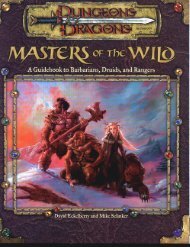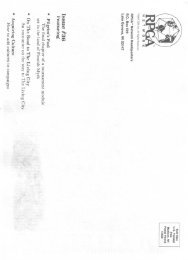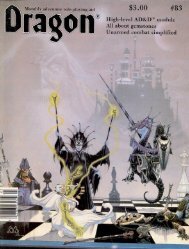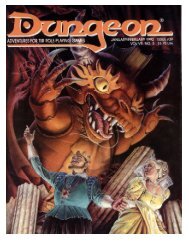Accessory - Dragon Magazine #111.pdf - Index of
Accessory - Dragon Magazine #111.pdf - Index of
Accessory - Dragon Magazine #111.pdf - Index of
Create successful ePaper yourself
Turn your PDF publications into a flip-book with our unique Google optimized e-Paper software.
Pull the pin and throw<br />
Grenades get more detail for TOP SECRET® play<br />
by Kevin Marzahl<br />
Contrary to popular belief, grenades are<br />
not powerful enough to blow out the side <strong>of</strong><br />
a building — an outhouse, perhaps, but<br />
nothing like a well-built <strong>of</strong>fice complex.<br />
However, grenades have more uses than<br />
blowing things up, as will be shown later. A<br />
brief history <strong>of</strong> the hand grenade follows,<br />
with a discussion <strong>of</strong> the different types <strong>of</strong><br />
grenades, how they function, and how to<br />
use them in the TOP SECRET® game<br />
system.<br />
History<br />
Webster’s New World Dictionary defines<br />
a grenade as “a small bomb detonated by a<br />
fuse and thrown by hand or fired from a<br />
rifle.” This certainly applies to the hand<br />
grenades <strong>of</strong> today, but the first “grenade”<br />
used in history was probably a clay pot<br />
filled with poisonous snakes, burning oils,<br />
or acids, and thrown by hand at an enemy.<br />
Such primitive grenades most likely originated<br />
in the Far East with the barbaric<br />
Mongols. They were also used in Medieval<br />
sieges.<br />
Grenades reappeared during the American<br />
Revolutionary War. Black powder was<br />
used as an explosive in grenade form,<br />
though its use was primarily limited to the<br />
bombing <strong>of</strong> the riggings and powder magazines<br />
<strong>of</strong> British ships. Grenades were improved<br />
during the American Civil War, as<br />
powder delay fuses were added.<br />
Not much more happened with grenades<br />
until World War I. Here came an explosion<br />
<strong>of</strong> grenade designs, stemming from the<br />
peculiarities <strong>of</strong> trench warfare. However,<br />
most <strong>of</strong> these grenades did not get far and,<br />
in World War II, warring countries fell back<br />
on the tried and true grenades <strong>of</strong> World War<br />
I. Most <strong>of</strong> these were forms <strong>of</strong> the fragmentation<br />
grenade. For the British, it was the<br />
Mills Bomb; for the Germans, it was the<br />
famous “Potato Masher” stick grenade,<br />
drawing its unusual name from the kitchen<br />
utensil it resembled. World War II also<br />
marked the birth <strong>of</strong> the white phosphorus,<br />
or WP, grenade, which hurls particles <strong>of</strong><br />
burning chemical upon explosion. Since<br />
then grenades have been improved and<br />
specialized. What was once a military tool<br />
has found its way into riot control and even<br />
espionage.<br />
Functioning<br />
The different types <strong>of</strong> grenades all share<br />
four common characteristics:<br />
3. Knockdown Radius (KDR)<br />
4. Time Delay Fuse (TDF)<br />
Range depends upon the weight and<br />
shape <strong>of</strong> the grenade, as well as the thrower’s<br />
ability. The ranges for individual grenades<br />
that are listed on the Grenade Table<br />
in Part II are the ranges that the grenades<br />
are best suited for, although all grenades<br />
can be thrown a maximum <strong>of</strong> 100’. A<br />
character’s chance <strong>of</strong> hitting on target with<br />
a grenade is inversely proportional to the<br />
range. A character would have a 95%<br />
chance <strong>of</strong> being on target at a range <strong>of</strong> 5’,<br />
and only a 5% chance <strong>of</strong> being on target at<br />
95’ away. If the grenade is thrown within<br />
the range listed on the Grenade Table, add<br />
8% to the character’s chance to hit on target.<br />
The maximum percentage chance to hit<br />
a target cannot exceed 95%.<br />
Effective Casualty Radius (ECR) is the<br />
radius <strong>of</strong> an area around the point <strong>of</strong> deto- knows, all one must do to use a grenade is<br />
nation within which exposed personnel pull the pin and throw. But what happens<br />
become casualties. in between these actions and the explosion?<br />
Knockdown Radius (KDR) is the radius First, the pulling <strong>of</strong> the pin. In the ac<strong>of</strong><br />
an area around the point <strong>of</strong> detonation companying diagram, the pin would be<br />
within which the Stopping Power Rules placed through the hole (1). After the pin is<br />
should be applied (see the TOP SECRET pulled, one would normally throw the gre-<br />
Companion, page 41-42, or DRAGON® nade. However, if you pull the pin and<br />
issue #49, page 24). As a general rule, all don’t throw the grenade, the device will not<br />
grenades and 40mm ammunition will inca- go <strong>of</strong>f in your hand. The reason for this is<br />
pacitate an unprotected human target. that the pin is merely holding the safety<br />
Time Delay Fuse (TDF) is the length <strong>of</strong> lever (2) in place. The lever, or “spoon” as<br />
time between the ignition <strong>of</strong> the primer and it is sometimes called, is holding the striker<br />
detonation. (3) in place. Once the thrower lets go <strong>of</strong> the<br />
In addition, all grenades share a common lever, the striker, powered by a small spring,<br />
assembly consisting <strong>of</strong> three basic parts: moves to hit the primer (4). The primer, in<br />
1. Fuse Assembly — The safety lever, turn, activates the delay element (5). After<br />
safety pin, striker, primer, delay element, the delay element has finished burning, it<br />
and detonator or ignitor. activates the detonator or ignitor (6), which<br />
2. Body — The container that holds the causes the grenade to go <strong>of</strong>f.<br />
fuse assembly and filler.<br />
3. Filler — The substance with which the Grenades and launchers<br />
body is filled: chemicals, high explosives, or What kind <strong>of</strong> grenades can agents obtain,<br />
gas. and what can they do? The table below lists<br />
the grenades described in this article, their<br />
The manner in which these three parts four characteristics, damage (explained in<br />
function together is quite simple. As anyone detail under the grenade descriptions), and<br />
Type<br />
Fragmentation<br />
White phosphorus<br />
Concussion<br />
Thermite<br />
Smoke<br />
Gas<br />
Range E C R KDR TDR Weight cost<br />
(feet) (feet) (feet) (seconds) Damage (pounds) ($ U.S.)<br />
80 40 5 4-5 special 1 20<br />
70 55 5 4-5 “Z” 2 50<br />
70 20 10 4-5 special 1 15<br />
60 — — 2 special 2.5 35<br />
70 — — 2 — 1 10<br />
70 special 15 2 varies 1 20<br />
1. Range Flare 80 — — 7 — 1 15<br />
2. Effective Casualty Radius (ECR) Stun 60 — special .5 special 2 100<br />
66 JULY 1986







